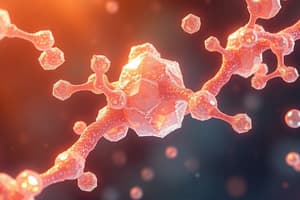Podcast
Questions and Answers
Which group of monosaccharide derivatives is formed by replacing a hydroxyl group with a hydrogen atom?
Which group of monosaccharide derivatives is formed by replacing a hydroxyl group with a hydrogen atom?
- Amino sugars
- Sugar acids
- Deoxy sugars (correct)
- Sugar alcohols
What type of acid is produced by the oxidation of the last hydroxyl carbon of a monosaccharide?
What type of acid is produced by the oxidation of the last hydroxyl carbon of a monosaccharide?
- Aldonic acid
- Aldaric acid
- Uronic acid (correct)
- Hydroxyl acid
Which derivative of monosaccharide is crucial for the structure of glycoproteins and glycolipids?
Which derivative of monosaccharide is crucial for the structure of glycoproteins and glycolipids?
- Amino sugars (correct)
- Sugar phosphates
- Sugar acids
- Sugar alcohols
Which enzyme family is responsible for catalyzing the phosphorylation reactions of monosaccharides?
Which enzyme family is responsible for catalyzing the phosphorylation reactions of monosaccharides?
What does not occur during the synthesis of amino sugars?
What does not occur during the synthesis of amino sugars?
What type of bond links the monosaccharide units in starch?
What type of bond links the monosaccharide units in starch?
Which derivative of monosaccharides is produced by the reduction of a carbonyl group to an alcohol?
Which derivative of monosaccharides is produced by the reduction of a carbonyl group to an alcohol?
Which type of acid involves oxidation of both the carbonyl carbon and the last hydroxyl carbon?
Which type of acid involves oxidation of both the carbonyl carbon and the last hydroxyl carbon?
Which homopolysaccharide is primarily found in plants and serves as a storage form of energy?
Which homopolysaccharide is primarily found in plants and serves as a storage form of energy?
Which of the following monosaccharide derivatives is NOT a component of certain antibiotics?
Which of the following monosaccharide derivatives is NOT a component of certain antibiotics?
What distinguishes glycogen from the other homopolysaccharides mentioned?
What distinguishes glycogen from the other homopolysaccharides mentioned?
Which description is true regarding the structure of amylose?
Which description is true regarding the structure of amylose?
What is the primary role of cellulose in plants?
What is the primary role of cellulose in plants?
Which of the following polysaccharides is used as a storage form of energy in animal cells?
Which of the following polysaccharides is used as a storage form of energy in animal cells?
Which characteristic is unique to heteropolysaccharides compared to homopolysaccharides?
Which characteristic is unique to heteropolysaccharides compared to homopolysaccharides?
What best describes the composition ratio of amylose and amylopectin in starch?
What best describes the composition ratio of amylose and amylopectin in starch?
What type of glycosidic bond is present in sucrose?
What type of glycosidic bond is present in sucrose?
Which enzyme is responsible for the hydrolysis of maltose?
Which enzyme is responsible for the hydrolysis of maltose?
What distinguishes reducing disaccharides from non-reducing disaccharides?
What distinguishes reducing disaccharides from non-reducing disaccharides?
Which of the following pairs are correctly linked by glycosidic bonds?
Which of the following pairs are correctly linked by glycosidic bonds?
What is the configuration of the anomeric -OH group in the bond formation of maltose?
What is the configuration of the anomeric -OH group in the bond formation of maltose?
Which disaccharide is produced through the digestion of starch and glycogen?
Which disaccharide is produced through the digestion of starch and glycogen?
Which of the following statements is true about lactose?
Which of the following statements is true about lactose?
Which term describes the mixture produced when sucrose undergoes hydrolysis?
Which term describes the mixture produced when sucrose undergoes hydrolysis?
What type of linkage occurs at the branch points in glycogen?
What type of linkage occurs at the branch points in glycogen?
Which of the following carbohydrates is composed primarily of D-fructose linked by β-(2→1) glycosidic bonds?
Which of the following carbohydrates is composed primarily of D-fructose linked by β-(2→1) glycosidic bonds?
What is a key reason cellulose has no food value for humans?
What is a key reason cellulose has no food value for humans?
What distinguishes chitin from cellulose in terms of chemical structure?
What distinguishes chitin from cellulose in terms of chemical structure?
Inulin is hydrolyzed by which enzyme when it occurs naturally in plants?
Inulin is hydrolyzed by which enzyme when it occurs naturally in plants?
What is the primary function of dextrans in dental plaque?
What is the primary function of dextrans in dental plaque?
Which of the following polysaccharides is known to consist of linear unbranched chains?
Which of the following polysaccharides is known to consist of linear unbranched chains?
What is the molecular structure of dextrins when starch undergoes partial hydrolysis?
What is the molecular structure of dextrins when starch undergoes partial hydrolysis?
Flashcards
Sugar Phosphates
Sugar Phosphates
Sugars with a phosphate group attached. They are formed by phosphorylation reactions catalyzed by enzymes called protein kinases.
Deoxy Sugars
Deoxy Sugars
Sugars in which a hydroxyl group (-OH) is replaced by a hydrogen atom (-H). Deoxyribose is an important deoxy sugar found in DNA.
Amino Sugars
Amino Sugars
Sugars with an amino group (NH2) or an acetyl-amino group (CH2CO-NH-) replacing the hydroxyl group on carbon 2. They are essential components of diverse molecules like glycoproteins and certain antibiotics.
Sugar Alcohols
Sugar Alcohols
Signup and view all the flashcards
Sugar Acids
Sugar Acids
Signup and view all the flashcards
Glucose-6-phosphate
Glucose-6-phosphate
Signup and view all the flashcards
L-Fucose
L-Fucose
Signup and view all the flashcards
Amino Sugar Acids
Amino Sugar Acids
Signup and view all the flashcards
Glycosidic Bonds
Glycosidic Bonds
Signup and view all the flashcards
O-Glycosidic Linkage
O-Glycosidic Linkage
Signup and view all the flashcards
N-Glycosidic Linkage
N-Glycosidic Linkage
Signup and view all the flashcards
Disaccharide
Disaccharide
Signup and view all the flashcards
Reducing Disaccharide
Reducing Disaccharide
Signup and view all the flashcards
Non-reducing Disaccharide
Non-reducing Disaccharide
Signup and view all the flashcards
Sucrose
Sucrose
Signup and view all the flashcards
Maltose
Maltose
Signup and view all the flashcards
Polysaccharides
Polysaccharides
Signup and view all the flashcards
Homopolysaccharides
Homopolysaccharides
Signup and view all the flashcards
Heteropolysaccharides
Heteropolysaccharides
Signup and view all the flashcards
Starch
Starch
Signup and view all the flashcards
Amylose
Amylose
Signup and view all the flashcards
Amylopectin
Amylopectin
Signup and view all the flashcards
Glycogen
Glycogen
Signup and view all the flashcards
Cellulose
Cellulose
Signup and view all the flashcards
Liver glycogen's role in blood glucose regulation
Liver glycogen's role in blood glucose regulation
Signup and view all the flashcards
Muscle glycogen's function
Muscle glycogen's function
Signup and view all the flashcards
Glycogen's structure
Glycogen's structure
Signup and view all the flashcards
Cellulose's structure and function
Cellulose's structure and function
Signup and view all the flashcards
Why humans can't digest cellulose
Why humans can't digest cellulose
Signup and view all the flashcards
Chitin's structure and function
Chitin's structure and function
Signup and view all the flashcards
Dextrans: Structure and source
Dextrans: Structure and source
Signup and view all the flashcards
Dextrins: Formation and properties
Dextrins: Formation and properties
Signup and view all the flashcards
Study Notes
Carbohydrate Chemistry
- Carbohydrates are crucial for diverse biological functions
- Monosaccharides are the simplest carbohydrates
- They're categorized into aldoses (aldehyde group) and ketoses (ketone group)
- Monosaccharides can be further modified to produce derivatives
Monosaccharide Derivatives
- Sugar Phosphates: These are formed by phosphorylation, a reaction catalyzed by protein kinases. ATP donates the phosphate.
- Sugar alcohols: Formed by reduction of the carbonyl group; glucose becomes glucitol (sorbitol)
- Sugar acids: Formed by oxidation of the carbonyl group or the hydroxyl group: glucose forms gluconic acid or glucuronic acid. Aldaric acids result from oxidation of both.
- Deoxy Sugars: Have a hydroxyl group replaced by a hydrogen; deoxyribose is notable. Example: L-Fucose
- Amino Sugars: Hydroxyl group replaced with an amino or acetyl amino group. Glucosamine, galactosamine, and mannosamine.
Glycosidic Bonds
- Glycosidic bonds link monosaccharides to form disaccharides and polysaccharides
- Bonds are named based on the numbered carbon atoms involved and the configuration of the anomeric hydroxyl group (α or β)
Disaccharides
- Two monosaccharides linked by a glycosidic bond
- Subdivided into reducing (free aldehyde or ketone) and non-reducing (no free aldehyde or ketone) types
- Examples: Maltose, Sucrose, Lactose, and Isomaltose are common disaccharides
Polysaccharides
- Long chains of monosaccharides
- Subdivided into homopolysaccharides (single monosaccharide) and heteropolysaccharides (multiple monosaccharides)
- Examples: Starch, Glycogen, Cellulose, and Chitin
- Starch: Composed of amylose (linear) and amylopectin (branched).
- Glycogen: Animal starch, highly branched
- Cellulose: Plant cell walls, linear, not digestible by humans; important for fiber
- Chitin: Exoskeletons of insects and crustaceans, similar to cellulose but with a substituted amino group
- Dextrans and Dextrins: derived from bacterial or yeast, or starch
Other Carbohydrates
- Inulin: A fructose polymer found in plant roots, notable for physiological studies and body water measurements.
Studying That Suits You
Use AI to generate personalized quizzes and flashcards to suit your learning preferences.




